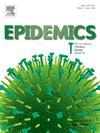基于超人口网络和卡尔曼滤波的北美地区COVID-19模型
IF 2.4
3区 医学
Q2 INFECTIOUS DISEASES
引用次数: 0
摘要
背景:了解传染病传播动态并预测临床结果对于管理大规模流行病和流行病(如COVID-19)至关重要。相互联系人群中疾病传播的有效建模有助于为跨区域的公共卫生反应和干预提供信息。方法:我们开发了一种新的元种群模型来模拟北美地区呼吸道病毒的传播,特别是加拿大、墨西哥和美国的96个州、省和地区。该模型由COVID-19病例数据提供信息,这些数据使用贝叶斯推理算法集成调整卡尔曼滤波(EAKF)同化。此外,通勤和移动数据用于建立和调整每天在不同地点之间的网络和移动。该模型推理系统提供了2020年1月至2021年3月期间96个地点的传播动态、感染率和确定率的估计值。结果突出了这三个国家在疾病动态和确定方面的差异。结论:超种群结构可以实现大尺度的快速模拟,数据同化方法可以使系统对系统动力学变化做出响应。该模型可作为北美地区其他传染病建模的通用平台。本文章由计算机程序翻译,如有差异,请以英文原文为准。
Modelling COVID-19 in the North American region with a metapopulation network and Kalman filter
Background
Understanding the dynamics of infectious disease spread and predicting clinical outcomes are critical for managing large-scale epidemics and pandemics, such as COVID-19. Effective modeling of disease transmission in interconnected populations helps inform public health responses and interventions across regions.
Methods
We developed a novel metapopulation model for simulating respiratory virus transmission in the North America region, specifically for the 96 states, provinces, and territories of Canada, Mexico, and the United States. The model is informed by COVID-19 case data, which are assimilated using the Ensemble Adjustment Kalman filter (EAKF), a Bayesian inference algorithm. Additionally, commuting and mobility data are used to build and adjust the network and movement across locations on a daily basis.
Results
This model-inference system provides estimates of transmission dynamics, infection rates, and ascertainment rates for each of the 96 locations from January 2020 to March 2021. The results highlight differences in disease dynamics and ascertainment among the three countries.
Conclusions
The metapopulation structure enables rapid simulation at a large scale, and the data assimilation method makes the system responsive to changes in system dynamics. This model can serve as a versatile platform for modeling other infectious diseases across the North American region.
求助全文
通过发布文献求助,成功后即可免费获取论文全文。
去求助
来源期刊

Epidemics
INFECTIOUS DISEASES-
CiteScore
6.00
自引率
7.90%
发文量
92
审稿时长
140 days
期刊介绍:
Epidemics publishes papers on infectious disease dynamics in the broadest sense. Its scope covers both within-host dynamics of infectious agents and dynamics at the population level, particularly the interaction between the two. Areas of emphasis include: spread, transmission, persistence, implications and population dynamics of infectious diseases; population and public health as well as policy aspects of control and prevention; dynamics at the individual level; interaction with the environment, ecology and evolution of infectious diseases, as well as population genetics of infectious agents.
 求助内容:
求助内容: 应助结果提醒方式:
应助结果提醒方式:


